Audi TT RS
Audi’s relentless pursuit of BMW and Mercedes in recent years is finally beginning to bear fruit. Years of product planning and brand building efforts are showing desired results, as they top the sales charts in Western Europe and China for the premium market segment. Back at their home continent, Audi managed to put 45,124 cars on the road during January 2009, while in China, over 12,000 Audis were sold in the month of April 2009.
It’s not quite accurate to say that Audi is currently breathing down the necks of Merc and BMW. No, Audi are hammering them, and that is set to continue, with the new TT RS taking aim at the higher end versions of the BMW Z4 and the Merc SLK. Developed by quattro GmbH, the TT RS is powered by a 2.5-litre inline-5 TFSI engine good for 340hp, sent to all four wheels via the famous quattro all-wheel drive system.
In terms of pricing (UK prices) and output, the £42k (coupe) TT RS sits a rung above the Z4 sDrive35i (302hp, £37k) and SLK 350 (300hp, £36k), but below the SLK 55 AMG (355hp £52k). The now discontinued Z4 M, with 338hp, would have served as an interesting match up against the top dog TT, which Audi audaciously labels as the ‘purist driving machine’ – an obvious dig at the Ultimate Driving Machine.
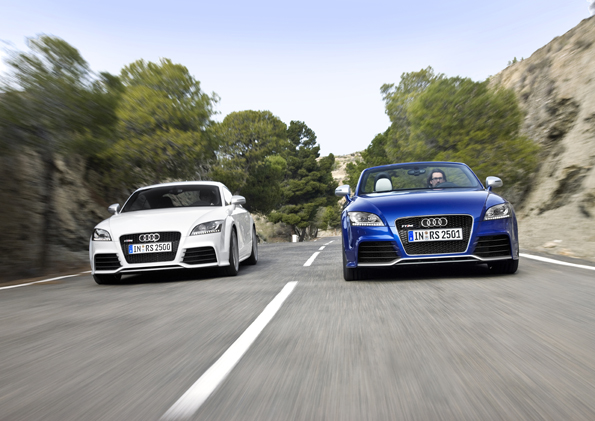
Audi TT RS Coupe (L) & Roadster (R)
Exterior
Audi has added various subtle design touches to differentiate the RS from the run-of-the-mill TTs. Although each change is reasonably minor on its own, they all add up to give a powerful visual effect. The single-frame grille is retained, but the rectangular slats are now replaced with a honeycomb design proudly wearing the “TT RS” badge alongside the four rings. Right below, is an aerodynamically functioning front splitter, optionally available in aluminum finish, working in tandem with the rear spoiler

Enlarged vents most visible signal of intent up front
The air intake vents flanking the grille are flared, enlarged, and actually purposeful. Unlike on the regular TT, the fog lights are omitted, allowing the left vent to channel air across the gearbox and the right vent to an additional water cooler. Above the vents, the pair of headlamps feature Audi’s now trademark daytime running lights, with 12 LEDs forming a straight line underlining the main bulbs.

Front splitter serves aerodynamic purpose. Aluminum finish available as an option.
Down the flanks, the side mirrors are finished in matt aluminum as standard, but optionally available in body colour or carbon finish, while the flared wheel arches from the standard TT are carried over. Sitting under the arches are 18″×9J wheels shod in 245/40 rubber, though owners can opt to upsize to 19″ items shod in 255/35 tyres, or go as high as 20 inches. Peeking from behind the wheels are powerful internally vented disc brakes (370mm up front, 310mm behind) with each caliper painted black and stamped with the “RS” logo.

18″ rims as standard equipment, but buyer can upsize to 19″ or even 20″
At the rear, a more elaborately designed rear bumper signals the TT RS’ sporting intent. The large oval tailpipes, a design cue presumably carried over from the R8 5.2 FSI, are visually joined by the matt black rear diffuser with a honeycomb surface pattern. Unlike the retracting spoiler on the high volume TTs, the spoiler on the TT RS is fixed, and more aggressive looking. On the Roadster the third brake light integrated onto the spoiler’s underside.

Rear diffuser and oval exhaust tips differentiate this from standard TT

Rear spoiler now fixed.
The TT RS occupies a reasonably small area of space, with a footprint measuring 4,198mm × 1,842mm. Regardless of version, the front face of the TT RS measures at a low 2.09m2, which reduces wind resistance going forward. For the magical drag coefficient numbers, Audi claims figures of 0.32 for the Coupe, and 0.34 for the Roadster.
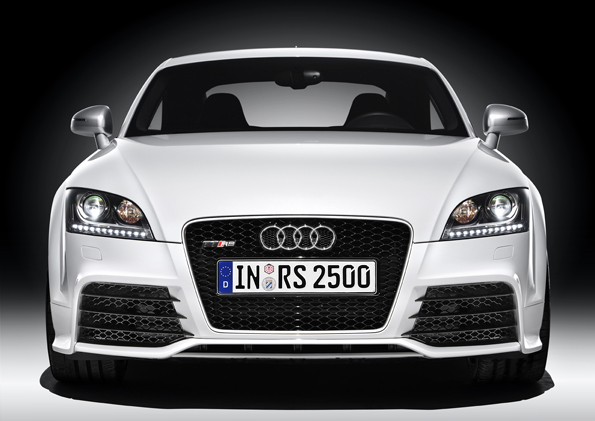
Frontal cross-sectional area measures 2.09m2 while Cd is rated at 0.32 (Coupe) and 0.34(Roadster).
Interior
Pictures released from the Audi press room to the international media shows a cabin with the typical ergonomic and build quality associated with the maker from Ingolstadt. Compared to cabins of the A4s and whatnots, the TT’s cabin has a few less buttons and a few more curves. In typical sports car fashion, the speedo and tacho are each recessed into a binnacle, while the thick rimmed steering is wrapped in perforated leather and flattened at the bottom.
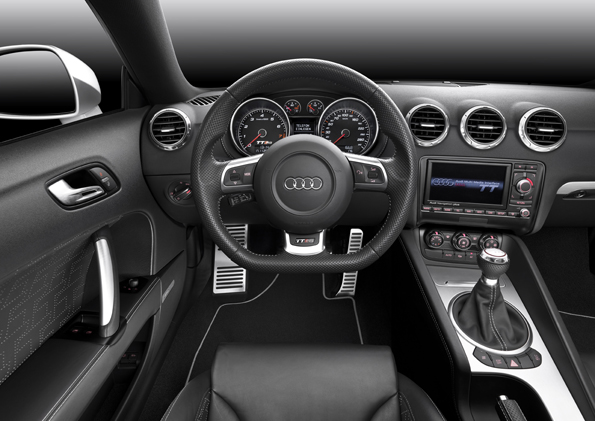
Interior features an extra touch of sportiness, with the usual high standards of an Audi cabin.
The entire interior is coloured in black, with brush aluminum finishes and “TT RS” logos sprinkled all over, including on the low mounted sports seats, which are finished in a combination of leather and Alcantara. Dominating the central dashboard is the Audi MMI interface, sitting between three circular air-con vents above, and three circular air-con control dials below.

MMI interface a prominent feature on the dashboard.
In terms of luggage capacity, the Coupe’s trunk space amounts to 290 litres, extendable to 700 litres, courtesy of split folding rear seatbacks. The Roadster makes do with 250 litres, optionally available with a load-through hatch and a removable ski sack, adding a touch of practicality to the interior. For the rainy days, the Roadster will have a soft top capable of folding in 12 seconds, even when driving at speeds up to 50kph.
Body & Chassis
Construction of the TT RS, both Coupe and Roadster, is based on Audi’s Space Frame (ASF) technology, which ensures not only minimum weight, but also optimum balance. The front end of the chassis, where the massive weight of the engine is situated, is composed of lightweight aluminum. In Audi’s own words, the “extruded sections, die-castings and aluminum sheets form an impact resistant structure of exceptional strength”. An exceptional claim indeed.
To balance out the weight distribution, the rear end is made of heavier steel sheets. In the case of the Coupe, its body structure is composed of 66kg steel, and 140kg aluminum, adding up to a total weight for the body-in-white (industry speak for the assembly of chassis and body panels, but without all the fittings) of 206 kg. For the Roadster, the additional reinforcements in its superstructure contributed to a 45kg penalty over the Coupe.
Adding all the engines, tyres, lubricants and various other goodies puts the Coupe’s weight at a healthy 1,450kg, while the Roadster has an extra 60kg to lug around. Supporting that weight on the four ends are McPherson struts up front, and a four-link suspension at the back. Compared to the standard TT, the TT RS sits 10mm closer to the ground, and users can opt to specify an electronic controller to work with the magnetic ride dampers, allowing a change of the damping characteristic in a matter of milliseconds.
For steering, the TT RS gets a variable ratio rack & pinion system. Audi goes on to add the claim that “because the electromechanical system does not require any energy when travelling straight, it is extremely efficient and saves approximately 0.2 litres of fuel per 100km.” Sounds impressive, though have no idea how theyarrived at the figure and then proceeded to verify it!
Powertrain & Performance
Under the hood of the TT RS, a transversely mounted 2,480cc TFSI powerplant resides. It is a long-stroke engine, designed with compact dimensions and minimum weight in mind. All five cylinders, with their bores measuring at 82.5mm each, are squeezed into a block measuring less than half a metre in length, at 494mm.

2,480cc, five cylinders, TFSI – 340hp @ 5,400-6,500rpm, 450Nm @ 1,600rpm – 5,300rpm.
The block itself is cast from vermicular graphite cast iron, a material first used in large turbodiesel engine, said to give an excellent combination of high rigidity and low weight. The pistons are cast from aluminum, weighing only 492 grams each. As a result, the engine of the TT RS is both compact in dimensions, and light in weight, tipping the scales at a low 183kg.
Feeding the engine is the Turbocharged-Fuel Stratified Injection (TFSI) system, with the turbo ramming air down its throat, and the FSI directly injecting precise amounts of fuel into the cylinders at a pressure of 120 bar. At full load, the turbo, with its 64m diameter compressor wheel, can (theoretically) ram 335 litres of air down the engine’s throat at a pressure of 1.2 bar. The injectors, meanwhile, are designed to introduce fuel into the combustion chamber in a swirling pattern, to achieve a cooling effect on the walls and eliminate the problem of knocking.
So, what did all these exercises in engineering result in? Well, for power, we are getting 340hp between 5,400rpm and 6,500rpm. Torque, all 450Nm of it, arrives as early as 1,600rpm, and stays until 5,300rpm. Consumption for the Coupe is claimed at 9.2l/100km, and for the Roadster, 9.5l/100km.
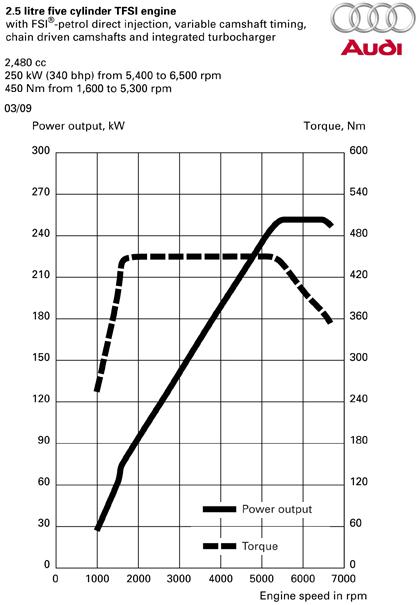
All that power and torque from the TFSI goes through a new six-speed manual transmission and then to Audi’s trademark quattro all-wheel drive system, which channels all the juice to the four wheels. For its application in the TT RS, Audi has toughened up the shafts and gears of this unit to take the additional power of the engine. The throws of the gears are said to be shortened; essential, because long throw and rubbery gear change would absolutely destroy the motoring experience in a car like this.
To further improve weight distribution, the multi-plate clutch, electronically activated but hydraulically actuated, is mounted just ahead of the rear axle. Furthermore, when the quattro system detects that the front wheels are slipping, it is able to instantly re-route power to the rear wheels to get the driver out of trouble.
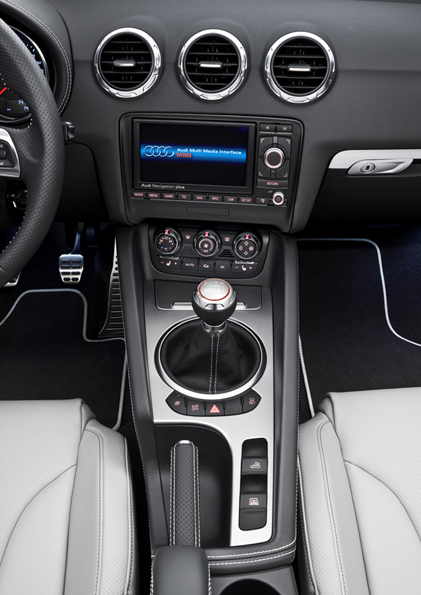
Six-speed manual connected to quattro all-wheel drive system.
So, how does all that translate to something usable for us on the road? Well, if you were to take off from standstill hunting for the top speed on a runway, 100kph will be reached in 4.6 seconds. The double ton arrives 11.3 seconds later, before the speedo bounces off the limiter at 250. Of course, you can have the limiter removed, allowing you to tip 280kph flat out.
Availability
Audi plans to commence deliveries of the TT RS in Europe by Summer 2009, pricing the Coupe at €55.8k and the Roadster at €58.7k. Euromobil is not likely to make it officially available in Malaysia, so interested buyers in our shores will need to keep an eye on grey importers.
























dispenses utilize a fantastic site decent Gives bless you for the efforts to help out me